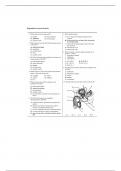Reproductive System Practice
1. Which structure stores sperm cells? 7. Males produce sperm;
A) bladder B) ductus deferens A) for as long as their pituitary gland secretes
C) epididymis D) prostate gland oxytocin
E) seminal vesicle B) for their entire lives, as long as their testosterone
level is high enough
2. Which structure secretes fluid that lubricates the end
of the penis? C) until all of the spermatogenic cells in the testes
have matured
A) bulbourethral gland D) until the age of 50
B) epididymis E) until the age of 80
C) prostate gland
8. Which sequence correctly outlines the pathway of
D) testes
sperm?1 urethra
E) seminal vesicle 2 seminiferous tubules
3. All of the following male reproductive structures are 3 epididymis
found internally, EXCEPT; 4 vas deferens
A) bulbourethral glands A) I, IV, III, II B) II, III, IV, I
B) ductus deferentia C) II, I, III, IV D) III, IV, II, I
C) prepuce E) III, II, IV, I
D) prostate gland 9. Through which structure do both urine and sperm exit
E) seminal vesicles the body?
4. Which region of a sperm cell contains enzymes that A) epididymis
help it to penetrate an egg cell? B) seminiferous tubules
A) acrosome B) follicle C) ureters
C) nucleus D) midpiece D) urethra
E) tail E) vas deferens
5. Which structure does NOT contribute to the 10. Through which structure does urine exit the body?
production of semen?
A) bulbourethral gland
B) corpus canvernosum
C) prostate gland
D) seminal vesicles
E) all of the above contribute to the production of
semen
6. All of the following are true regarding
spermatogenesis, EXCEPT;
A) at puberty primary spermatocytes reproduce by
meiosis
B) during it each primary spermatocyte splits to
create two secondary spermatocytes
C) it occurs continually in males, starting at puberty
D) it is also referred to as sperm cell production
E) men are born with a set number of mature sperm
cells A) 3 B) 4 C) 5 D) 6 E) 7
, 11. Semen consists of sperm cells from the testes and 15. Which of the following is the correct order of the
secretions from which of the following? layers of the uterine wall (from innermost to
outermost)?
A) endometrium, myometrium, perimetrium
B) endometrium, perimentrium, myometrium
C) myometrium, perimetrium, endometrium
D) perimetrium, myometrium, endometrium
E) perimetrium, endometrium, myometrium
16. In which part of the female reproductive system does
fertilization occur?
A) cervix B) Ovary
C) Uterine tube D) Uterus
E) Vagina
17. Which hormone most directly triggers ovulation?
A) Estrogen B) FSH
C) GnRH D) LH
E) TSH
A) 2, 4, 5 B) 3, 6, 8 18. All of the following statements regarding oogenesis
C) 2, 5, 9 D) 4, 6, 9 are true, EXCEPT;
E) 5, 6, 9
A) A single secondary oocyte results
12. The female menstrual cycle is characterized by B) If a second polar body is fertilized it becomes a
regular changes in the; zygote
A) cervix B) endometrium C) Mature oocytes have 46 chromosomes
C) fallopian tubes D) myometrium D) Polar bodies have no function and degenerate
E) perimetrium E) When a primary oocyte divides the cytoplasm is
distributed unequally
13. The female reproductive cycle is characterized by
regular changes in the; 19. What happens to an oocyte if it is not fertilized by a
sperm?
A) cervix B) endometrium
C) fallopian tubes D) myometrium A) It degenerates
E) perimetrium B) It divides
C) It is reabsorbed into the blood stream
14. Which of the following DOES NOT play a role in
D) It remains in the uterus
the development of female sex cells?
E) It returns to the ovary for the next month
A) anterior pituitary gland
20. Which structure receives sperm from the penis and is
B) hypothalamus
the channel through which an offspring passes
C) ovaries during childbirth?
D) thymus gland
E) all of the above play a role in the development A) cervix B) ovary
of female sex cells C) oviduct D) uterus
E) vagina




